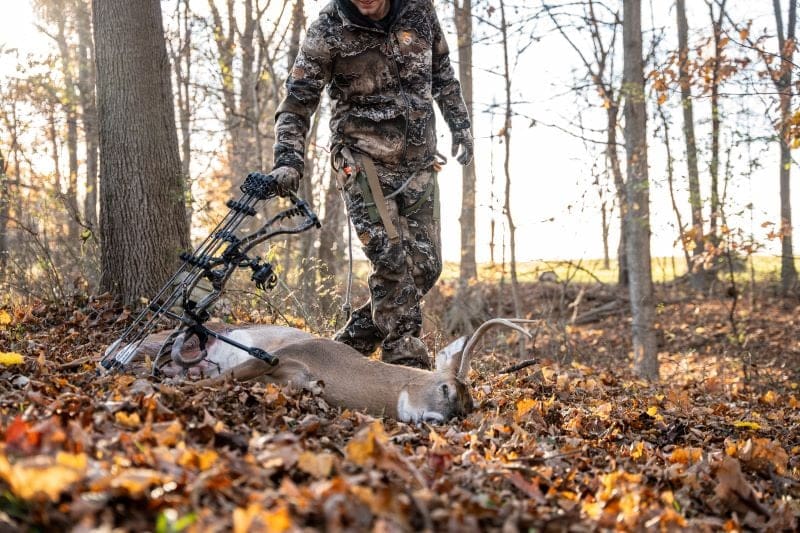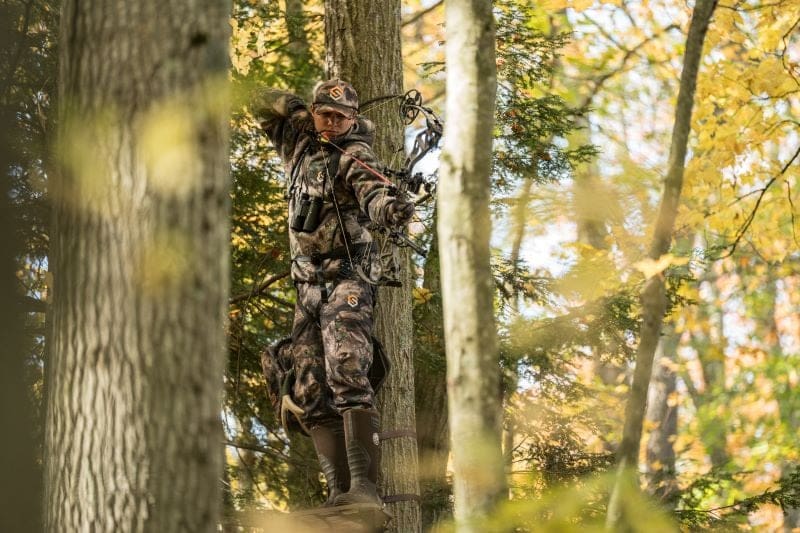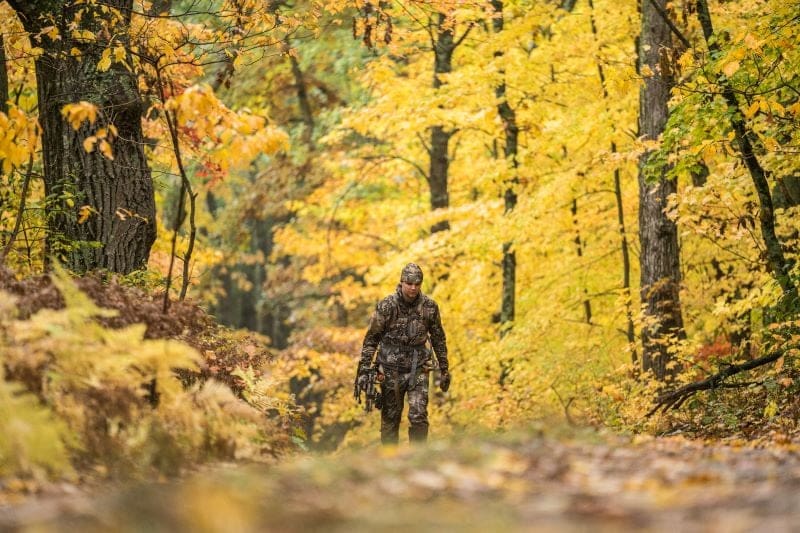Sitting patiently in my tree saddle on a recent afternoon hunt, I wondered if I was wrong about the October lull. For many years, I have said that I don’t believe the lull is something that happens to deer, making them halt their daily movements. I think weather, food sources such as acorns, and hunting pressure can alter movement to another area, making it seem like deer have disappeared. Yet, hunters can adjust to keep successfully hunting through October. The weather was unseasonably warm this afternoon, yet scrapes were everywhere, and I felt the need to be in a tree. After four hours in the saddle and no sightings of deer, it was hard not to reevaluate my line of thinking and wonder, is this the lull?
Later that evening, after a quiet sit with minimal deer activity, my cellular camera alerted me to two different bucks visiting my mock scrape. The following day, another camera captured three bucks, all showing early signs of chasing does. As if to confirm it, on my drive to work that same morning, I spotted a buck venturing into an urban area where deer typically only appear when the rut is approaching. With all these clear signs of pre-rut activity, I found myself asking the same question many hunters would: Is the October lull officially over? And if so, what comes next?
As the leaves change and temperatures drop, many hunters face this familiar phenomenon known as the October lull. Typically occurring in the second half of October, this period is characterized by a noticeable decrease in deer movement and hunting success. This lull can be a source of frustration and uncertainty for seasoned hunters.

What Is the October Lull?
The October lull refers to a period during late October when deer activity for hunters seems to diminish. During this time, hunters often complain of fewer sightings and less consistent movement, leading to a dip in their hunting success. As I mentioned earlier, various theories attempt to explain this behavior instead of chalking it up as a mystery of what happened to the deer.
October often brings fluctuating temperatures and changing weather patterns. Deer may alter their routines in response to cooler nights and warmer days, leading to decreased daytime movement. As on my recent afternoon hunt, when the daytime highs reach seventy-five to eighty degrees, what happened to deer movement is self-explanatory: It is too hot, so they tend to move at night. When I get most of my game camera pictures from 9:00 p.m. to 3:00 a.m., that tells me that deer are moving at night when it is cooler.
As acorns and other food sources become abundant, deer may become more localized, spending extended periods in areas with plentiful food and reducing their need to travel widely during daylight hours. In my home range of southern Missouri, the acorns are abundant, meaning deer have food everywhere and a lot of timber. All the fields, food plots, and open areas where many hunters typically have their stand or blind setups seem to have no deer movement. This is because deer are in heavier cover, feeding on acorns.
As the month progresses, deer prepare for the rut, shifting their focus from feeding to breeding. This change in priority can lead to reduced daytime activity as bucks roam less. At the same time, they gather energy for the upcoming breeding season; hunters typically get photos at night, and the scrapes get worked more often. The problem is that it is throughout the night as well.
With the onset of the hunting season, deer may also alter their behavior to avoid human activity. This can lead to changes in movement patterns, with deer becoming more nocturnal in response to hunting pressure. I often notice that the more I hunt an area, the more deer patterns change. The same goes for public land; the more hunters that start exploring and scouting through the woods and hunting, the more pressure the deer, in turn, feel, which can often lead to changed travel patterns.
When Is the Lull Over?
Typically, the October lull dissipates as we move into early November. As the days grow shorter and temperatures drop, hormonal changes signal the approaching rut. For many hunters, the first week of November marks the transition from the lull to peak activity, particularly as bucks become more aggressive in their pursuit of does.
While the lull can vary by region due to local climate conditions and deer populations, recognizing signs of the upcoming rut is crucial. For example, increased activity is near when my game cameras pick up scraping, rubbing, and general movement. These types of activity can indicate that deer are starting to stir again and think about breeding.

Strategies for Late October Hunting
As the October lull ends, adapting your hunting strategies is essential to capitalize on the increased deer movement.
Late October is a prime time to hunt near food sources. One of the reasons I often bark at the idea of a true lull is that if you move to where deer are feeding heavily, you will be in the right spot once the pre-rut activity begins. With deer feeding heavily to prepare for the rut, setting up near acorn-rich areas, agricultural fields, or food plots can yield great results. Utilizing trail cameras to monitor deer activity around these areas allows the hunter to see the exact moment when bucks switch from food to breeding.
As the rut approaches, deer activity can increase throughout the day. Consider all-day hunts, particularly during the last week of October. Bring snacks and gear to stay comfortable, as this can significantly increase your chances of encountering a buck on the move.
Another indication that you must be in the stand hunting is the weather.Be aware of weather conditions, as deer often respond to temperature and barometric pressure shifts. Cold fronts can trigger increased movement, so be prepared to head out when a front is approaching. Hunting during the early morning or late afternoon when temperatures are cooler can also be highly effective now, whereas days prior, it was night movement only.
As bucks seek out does, utilizing calls and scent attractants can also enhance your hunting strategy. Rattling or using estrous scents can lure in curious bucks, especially as they start to feel the urge to breed. As mentioned, I love using a mock scrape and a game camera to indicate when the lull is over. Scrapes and scents will be active at night for a couple of weeks. As soon as buck activity shows up during the day, I know I must be in the stand hunting, as this means the rut is near, and bucks will soon leave scrapes to pursue does. Those last few days of daylight movement can be deadly for hunters.
If you find that your initial setups aren’t producing results, don’t hesitate to move. Being mobile allows you to adapt to deer movements and capitalize on fresh signs. Use climbing stands or portable setups such as a tree saddle to shift locations quickly.
The October lull can be challenging for hunters, but understanding its dynamics and preparing for the transition into November can lead to fruitful hunting experiences. By focusing on food sources, staying aware of deer activity signs, and adapting strategies to the changing conditions, hunters can turn the end of the lull into a successful start to the rut. As the deer become more active, your chances of a successful hunt will increase.

